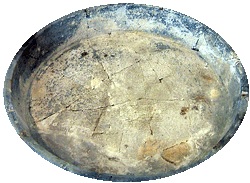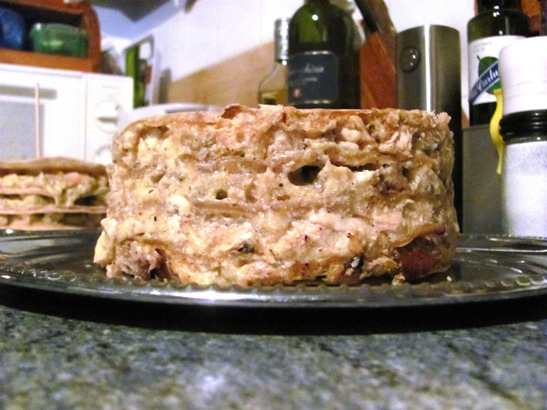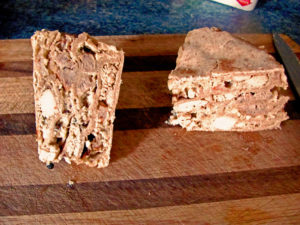For our fourth entry in the Ancient Roman Cookoff, we have none other than Sally Grainger cooking for us. Sally is author of Cooking Apicius: Roman Recipes for Today and with historian Andrew Dalby, she is co-author of The Classical Cookbook and its recently revised edition. For her entry, she chose a patella of mixed meat. The original recipe calls for tidbits of fine meats to be used. In her case, she used, pheasant, chicken, lucanika sausage, pork belly, king prawns and monkfish. Sally layered these meats, along with eggs and spices in between layers of dough or bread, roasted and then cut into pieces for service.
Sally found a number of surprises, including how good it tasted after it was baked together after construction. She writes, “You make an Apician patina like this: pieces of cooked udder, flaked fish, chicken meat, figpeckers, or cooked breast of thrush, and whatever finest qualities things there may be . . .
Dice all these carefully apart from the figpeckers. Beat up raw eggs in oil. Pound pepper, lovage, pour on liquamen, wine, passum; put in pan so that it warms through and thicken with starch. Before this however put all the chopped meat in and bring it to the boil. When this is cooked, take it out with its sauce and ladle it into a dish in alternate layers with whole pepper corns and pine nuts in such a way that, with each layer, you spread out a ‘double layer’ like a lagana (clearly actually ‘a lagana like a ‘double layered (cloak). Fill as many ladles as lagana you put in and put (the mixture) on top. Then pierce one lagana with a reed and put it on top. Sprinkle with pepper. Beforehand you should have thickened the meat mixture with the broken eggs and put it in the pan with the seasonings (Apicius 4.2.14) The kind of bronze pan you ought to have is shown below.

This is quite a perplexing recipe and made more so because the information seems to have been dictated. It is quite common in Apicius to find confusion as to the order in which you work because the cook has forgotten to add a key instruction until the end. There seem to be two ways to tackle the recipe; either treat it as an early version of lasagne and use pasta sheets where lagana are required or, as I do, consider pasta rather anachronistic at this time and use something other than pasta: un-leaved bread is the actual translation of lagana in classical Latin. I also note that it is whole-wheat flat breads that the famous Oliveto restaurant in Oakland used when they made this dish for their Roman inspired menu.
It is not just a simple matter of cooked pasta or cooked bread of cause as the structure and finished appearance of the dish rather depends on whether the layered sheets and sauce is returned to the oven and/or left in the dish. If the layering material is pre cooked it might suggest not. This recipe does not state either way but the following recipes in Apicius for an ‘every day patina’ indicates that the very same kind of structured dish is turned out of the vessel onto a ‘discum’ or platter for service (Apicius 4.2.15). Why it should be made in a bronze vessel and then turned out again without being further cooked is somewhat strange of cause. Another question that is not easy to answer is how is a portion is served to the guest? Is it cut like a cake or are the layers removed individually? I believe the answer to this is connected to the meaning of the ‘double layered cloak’ a most perplexing phrase. I have elsewhere published my thoughts on this issue in my edition of Apicius I came up with a number of scenario’s all of which I shall attempt to duplicate for this cookoff.

I used a simple chapatti recipe for the bread and cook them on a metal bake stone over charcoal. An interesting phenomena associated with chapatti is the ability of the bread to puff up creating a steam pocket as if the bread was leavened. This may be the simple explanation for the double layered cloak. However, as they cool they tend to deflate which is less convincing. The wonderful concept of using whatever good things are available also makes the dish very flexible. I have pheasant, chicken, lucanika sausage, king prawns and a firm fleshed fish such as monkfish or shark/tuna. As to the sow’s udder: the ancient practise of consuming this organ either before or soon after the piglets are born is an unfortunate practise. However, the majority of a sow’s belly around the in-active udder is in fact belly pork and this will suffice as an alternative.
I have made fish sauce myself in the last few years and used my own for this recipe. It has a salt level of c. 15% and a protein of 10% and was made from whole mackerel. Because it has a relatively low salt level I find I can use it quite liberally without the salt overpowering everything else. It is not overly fishy either with complex meaty cheesy overtones.
The Bread (This recipe makes roughly 12 chapatis-like breads)
1 cup wholemeal flour
1 cup plain flour
salt to taste
water to bind
2 tablespoons olive oil
I used a preparation and cooking method derived from chapatti production.
For the Sauce
500ml white wine
250ml stock made using the meat juices
150ml Muscat de Beaumes de Venise or similar desert wine
3 tablespoons fish sauce
2 level coffee spoon roasted and ground lovage seeds
generous fresh ground pepper
4 eggs
60ml olive oil
The Filling
2 120 gm chicken fillets
1 small pheasant
300 gm belly pork strips
2 lucanika sausages or any high meat content sausage of choice
100gm large prawns
100gm monkfish
The dough is formed with sufficient water and with oil to make a firm dough which is kneaded lightly and rested. I made some bread on the hearth with a bake stone and charcoal fire while also using a heavy non stick frying pan for others. I divide the dough into 12 balls and covered the remainder while I worked with each one. The pan needs to be heated on medium heat until a small piece of flattened dough takes on a little colour when it cooks rather than staying pale or burning.
Take each piece of dough, flatten it and turn it in flour then roll/stretch to a round thin disk about 15-18cm. As each one is prepared it is immediately placed on the dry pan and turned after about 2-3 mins. After turning take a clean tea towel and press gently on one side of the bread and you will find the other side will puff up nicely After a couple of minutes only remove the bread and wrap in a tea towel so that they don’t dry out. I decided to pre-cook all the meats in advance to generate a stock so that the meat flavours will be concentrated. I also feel that this kind of dish was actually designed to use up left over pre -cooked meats from a previous feast.
Roast the pheasant and belly pork, strip the meat and dice. Poach/roast the chicken fillets and retain the cooking liquor. Cook the sausage. Flush out all the roasting tins with the chicken cooking liquor and make up to 250 ml with water. This along with the wine, muscat, lovage, my fish sauce and plenty of pepper was heated and the diced meat put in. After a brief re-boil I added starch – I actually had some wheat starch that a friend had made according to the instruction for making amylum in Pliny HN 18.76 and also Cato 87. This requires grinding as it is in the form of hard crystals. Corn flour is obviously a suitable alternative.
I added the raw fish at this point cut into small pieces so that the remaining heat could cook the prawns and monkfish without them becoming too tough. I then added the oil and eggs. I was unsure about numbers but in the end found 4 more than enough. It was gently brought back to heat though not boiled as I didn’t think a curdled mixture was desirable. It did become quite thick but not set or solid. The instructions to ladle the mixture suggest a semi liquid.
There was no possibility of a bronze patella sadly but a large straight sided casserole suited. I also decided to cut the bread to fit the dish. I feel that the bread makes the dish sturdy enough to be turned out and to be free standing. Any attractive layering would not be lost if the bread was left unevenly circular. To my shame I wasn’t able to achieve perfect circles!

The alternative method which has been my preferred method in the past involved dispensing with the bronze patella and layering the sauce and bread as before or in separate individual sandwiches. So you had bread, sauce, bread, bread, sauce, bread, bread, sauce, bread, bread etc. It didn’t look bad and could be cut like the other one but was also readily removed and rolled up like a wrap and eaten while staying clean. My premise has always been that, as lagana was bread, the dish had to be associated with eating with the fingers and keeping them clean. If the finished item was too soft and wet at the time of service, the breads main role would have been lost.

__________
Sally’s interpretations of this patella is intriguing and delicious, but, the recipe lacks so much detail (by today’s standards) that a great deal of interpretation and creativity is allowed. For example, another way to prepare the patina would be to explore a variation on the lagane or “double cloak” idea and to lay down two layers of cut noodles or thin-pancakes cooked by different methods: for example, and oven-roasted layer and a fried-layer.
We don’t know what the shape of ancient lagane were, whether they were pancake or chapati like or whether they were sheets of dough that were then cut like noodles. We do know that the Etruscans were eating them and didn’t boil them. Rather they were cooked over coals or fried. Boiled “pasta” may be a Muslim invention – the first written reference to it is at least in Arabic. Modern lagane from central and southern are broad flat noodles like wide tagliatella that are sometimes ruffled and sometimes not. They are made from durum wheat or the finer 0 wheat flour, water and salt. Ancient lagane were probably made from spelt, possibly with farina or semolina added.
Today these are enjoyed in soups with chickpeas and other legumes in Campagnia (as referenced in Horace) or in a mixed-meat ragu in Puglia which could be a descendant of the Apician recipe above (minus the layered construction and with tomatoes and a modern retinue of spices added). In some areas, lagane are cooked in goat’s milk instead of water or broth on Catholic saint’s days. Another way lagane are enjoyed today are fried and layered as a sweet preparation with nuts and sugar, reminiscent of the Central Asian “chuk-chuk”. Noodle dishes of the Silk Road indeed!
(Words by Sally Grainger with introduction and commentary by Laura Kelley; photo of Roman Patina borrowed from the internet; Photographs of the Mixed-meat Patella by Sally Grainger.)
